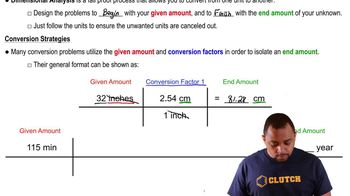Calicheamicin gamma-1, C55H74IN3O21S4, is one of the most potent antibiotics known: one molecule kills one bacterial cell. Describe how you would (carefully!) prepare 25.00 mL of an aqueous calicheamicin gamma-1 solution that could kill 1.0 * 108 bacteria, starting from a 5.00 * 10-9M stock solution of the antibiotic.
Ch.4 - Reactions in Aqueous Solution
Chapter 4, Problem 79
You want to analyze a silver nitrate solution. What mass of KCl is needed to precipitate the silver ions from 15.0 mL of 0.200 M AgNO3 solution? (c) Given that a 0.150 M HCl(aq) solution costs $39.95 for 500 mL and that KCl costs $10/ton, which analysis procedure is more cost-effective?
 Verified step by step guidance
Verified step by step guidance1
Step 1: Write the balanced chemical equation for the reaction between silver nitrate (AgNO_3) and potassium chloride (KCl). The reaction is AgNO_3(aq) + KCl(aq) -> AgCl(s) + KNO_3(aq).
Step 2: Calculate the moles of AgNO_3 in the solution. Use the formula: moles = concentration (M) x volume (L). Convert 15.0 mL to liters by dividing by 1000.
Step 3: Use the stoichiometry of the balanced equation to determine the moles of KCl needed. The reaction shows a 1:1 molar ratio between AgNO_3 and KCl.
Step 4: Calculate the mass of KCl required using the formula: mass = moles x molar mass. Find the molar mass of KCl by adding the atomic masses of K and Cl.
Step 5: Compare the cost-effectiveness of using KCl versus HCl. Calculate the cost of KCl needed for the reaction and compare it to the cost of using HCl, considering the given prices.
Key Concepts
Here are the essential concepts you must grasp in order to answer the question correctly.
Stoichiometry
Stoichiometry is the calculation of reactants and products in chemical reactions. It involves using balanced chemical equations to determine the relationships between the quantities of substances involved. In this question, stoichiometry is essential for calculating the mass of KCl needed to react with the silver ions from the AgNO3 solution.
Recommended video:
Guided course

Stoichiometry Concept
Precipitation Reactions
Precipitation reactions occur when two soluble salts react to form an insoluble product, known as a precipitate. In this case, KCl reacts with AgNO3 to form AgCl, which precipitates out of the solution. Understanding the solubility rules and the formation of precipitates is crucial for determining the amount of KCl required to remove silver ions from the solution.
Recommended video:
Guided course

Selective Precipitation
Cost Analysis
Cost analysis involves comparing the expenses associated with different procedures or materials to determine the most economical option. In this scenario, it requires calculating the total cost of using HCl versus KCl for the analysis, taking into account their concentrations and the volumes needed. This concept is vital for making informed decisions about which chemical analysis method is more cost-effective.
Recommended video:
Guided course

Dimensional Analysis
Related Practice
Textbook Question
Textbook Question
Pure acetic acid, known as glacial acetic acid, is a liquid with a density of 1.049 g/mL at 25 C. Calculate the molarity of a solution of acetic acid made by dissolving 20.00 mL of glacial acetic acid at 25 C in enough water to make 250.0 mL of solution.
1
views
Textbook Question
(a) What volume of 0.115 M HClO4 solution is needed to neutralize 50.00 mL of 0.0875 M NaOH?
Textbook Question
(b) What volume of HCl is needed to neutralize 2.87 g of Mg(OH)2?
1
views
Textbook Question
(c) If 25.8 mL of an AgNO3 solution is needed to precipitate all the Cl- ions in a 785-mg sample of KCl (forming AgCl), what is the molarity of the AgNO3 solution?
